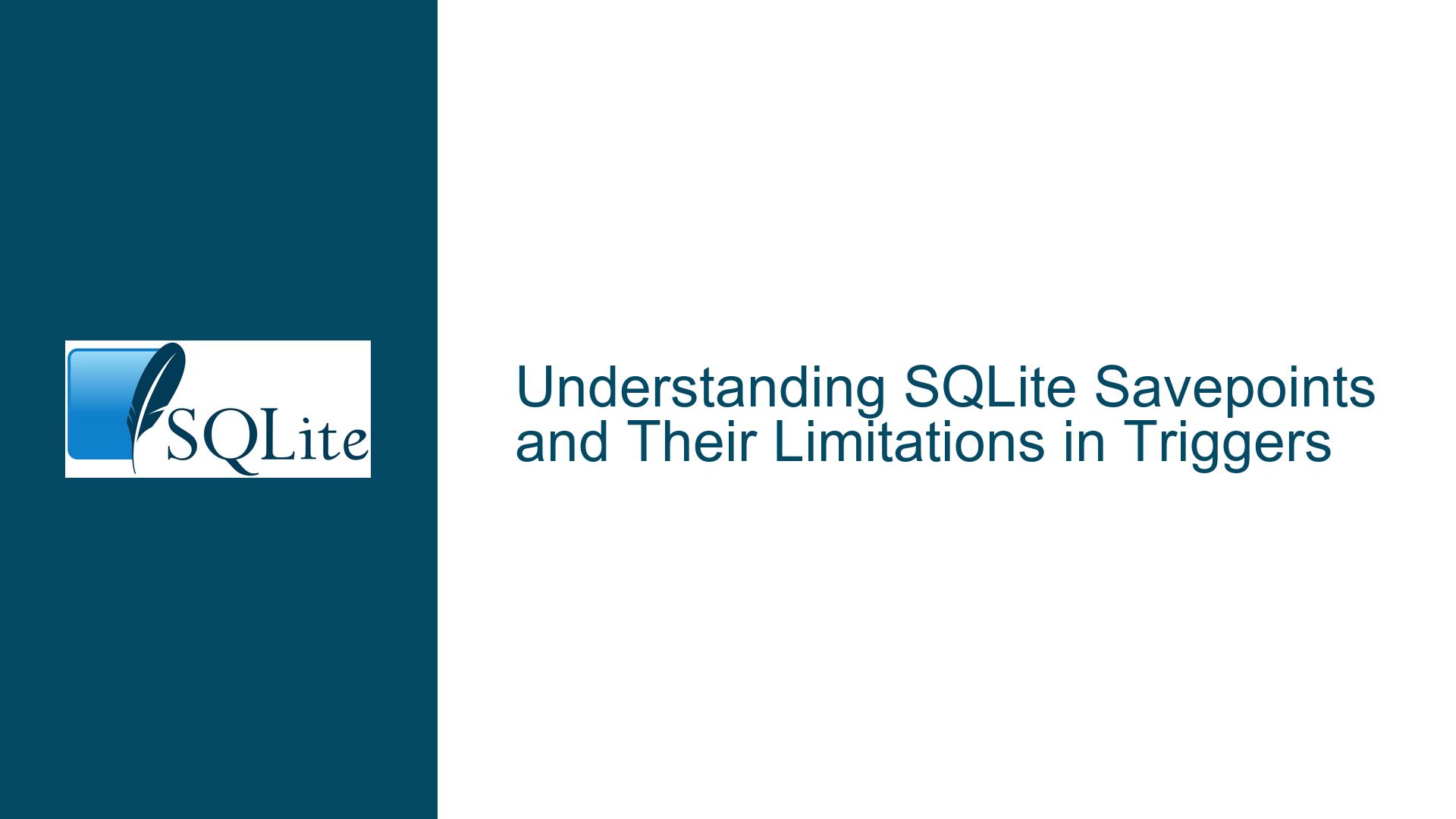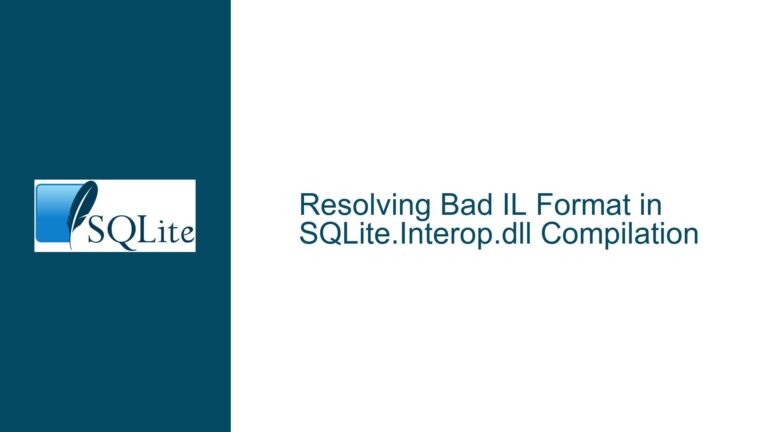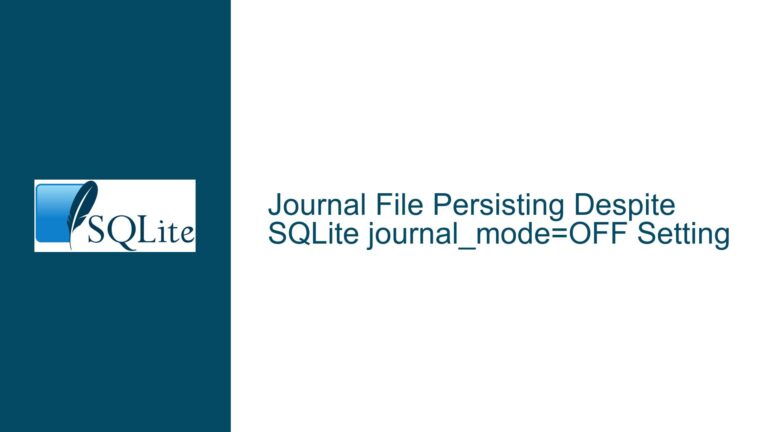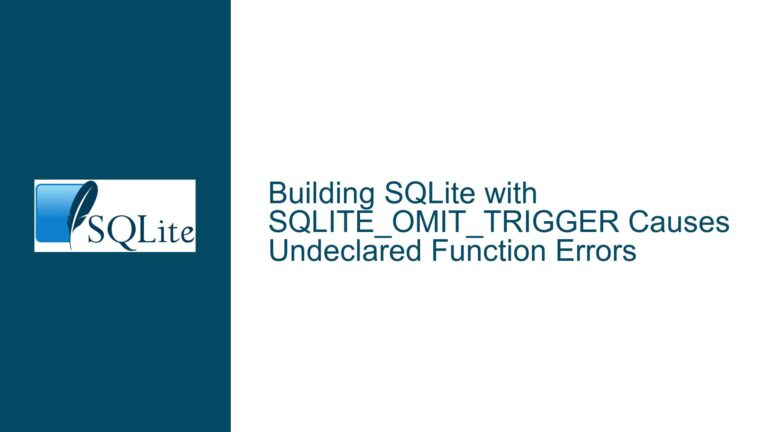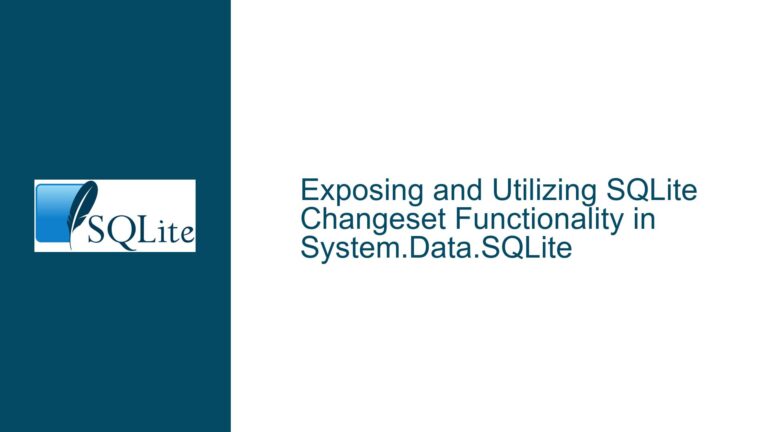SQLite Savepoints and Their Limitations in Triggers
SQLite Savepoints in Triggers: Unsupported and Problematic
SQLite is a powerful, lightweight database engine that supports a wide range of SQL features, including savepoints. Savepoints allow you to create nested transaction points within a larger transaction, enabling partial rollbacks without affecting the entire transaction. However, one area where SQLite explicitly restricts the use of savepoints is within triggers. This restriction can lead to confusion and unexpected behavior, especially for developers who assume that savepoints can be nested freely in all contexts.
The core issue arises when developers attempt to use savepoints within a trigger body. SQLite’s documentation clearly states that transaction control statements, including SAVEPOINT, RELEASE SAVEPOINT, and ROLLBACK TO SAVEPOINT, are not allowed within triggers. This limitation is not arbitrary but stems from the way SQLite handles transactions and triggers internally. Understanding why this restriction exists and how to work around it is crucial for writing robust and maintainable SQLite code.
When a trigger is executed, it is already running within the context of a transaction. This means that any changes made by the trigger are part of the larger transaction that invoked it. Introducing savepoints within a trigger would complicate the transaction model, potentially leading to inconsistent states or undefined behavior. For example, if a trigger creates a savepoint and then rolls back to that savepoint, it could inadvertently undo changes made by the outer transaction, leading to data integrity issues.
Interrupted Write Operations Leading to Index Corruption
One of the primary reasons SQLite disallows savepoints in triggers is to prevent scenarios where interrupted write operations could lead to index corruption or other data integrity issues. When a trigger is executed, it often performs multiple operations that depend on the consistency of the database state. If a savepoint were allowed within a trigger, and a rollback to that savepoint occurred, it could leave the database in an inconsistent state, particularly if the trigger modifies multiple tables or indexes.
For instance, consider a trigger that updates a parent table and a related child table. If the trigger creates a savepoint after updating the parent table but before updating the child table, and then a rollback to that savepoint occurs, the parent table would be reverted to its previous state, but the child table would remain unchanged. This inconsistency could lead to orphaned records or other data integrity issues that are difficult to diagnose and resolve.
Moreover, SQLite’s transaction model is designed to ensure atomicity, consistency, isolation, and durability (ACID) properties. Allowing savepoints within triggers could compromise these properties, particularly atomicity and consistency. For example, if a trigger creates a savepoint and then encounters an error, rolling back to the savepoint could leave the database in a partially updated state, violating the atomicity of the transaction.
Implementing PRAGMA journal_mode and Database Backup
Given the limitations of savepoints in triggers, developers must adopt alternative strategies to achieve similar functionality. One such strategy is to use SQLite’s PRAGMA journal_mode to control how transactions are logged and managed. The journal_mode pragma allows you to specify the journaling mode used by SQLite, which can affect the performance and reliability of transactions.
For example, setting PRAGMA journal_mode=WAL (Write-Ahead Logging) can improve concurrency and reduce the likelihood of database corruption in the event of a power failure or other interruption. WAL mode allows multiple readers and writers to access the database simultaneously, while still ensuring that transactions are atomic and durable. This can be particularly useful in scenarios where long-running transactions or complex triggers are involved.
Another important consideration is implementing robust database backup strategies. Regular backups can help mitigate the risk of data loss or corruption, particularly in scenarios where triggers perform complex operations that could potentially leave the database in an inconsistent state. SQLite provides several tools for creating backups, including the .backup command in the SQLite command-line interface and the sqlite3_backup_init API for programmatic backups.
In addition to these strategies, developers should carefully design their triggers to minimize the risk of data integrity issues. This includes avoiding complex logic within triggers, using conditional statements to control trigger execution, and ensuring that triggers are idempotent (i.e., they can be safely executed multiple times without causing unintended side effects).
For example, instead of using savepoints within a trigger, developers can use conditional logic to control the flow of operations within the trigger. The WHEN clause in the CREATE TRIGGER statement allows you to specify a condition that must be true for the trigger to execute. This can be used to prevent unnecessary operations and reduce the risk of data integrity issues.
Consider the following example, where a trigger is used to enforce a business rule that employees must be at least 16 years old:
CREATE TRIGGER enforce_minimum_age BEFORE INSERT ON employees
FOR EACH ROW
WHEN NEW.age < 16
BEGIN
INSERT INTO audit_log (employee_id, message)
VALUES (NEW.id, 'Employee is too young.');
-- Optionally, raise an error to prevent the insert
SELECT RAISE(ABORT, 'Employee must be at least 16 years old.');
END;
In this example, the trigger only executes if the age column of the new employee record is less than 16. This approach avoids the need for savepoints and ensures that the trigger only performs necessary operations.
Another approach is to use stored procedures or application-level logic to handle complex operations that would otherwise require savepoints within a trigger. By moving this logic outside of the database, you can take advantage of the full range of transaction control features available in your programming language or framework, while still maintaining the integrity of your database.
For example, instead of using a trigger to perform a complex update, you could write a stored procedure that performs the update within a transaction, using savepoints as needed. This approach allows you to maintain control over the transaction flow and handle errors in a way that is consistent with your application’s requirements.
CREATE PROCEDURE update_employee_salary(employee_id INTEGER, new_salary INTEGER)
BEGIN
SAVEPOINT before_update;
UPDATE employees SET salary = new_salary WHERE id = employee_id;
INSERT INTO audit_log (employee_id, message)
VALUES (employee_id, 'Salary updated to ' || new_salary);
-- Optionally, release the savepoint
RELEASE before_update;
END;
In this example, the stored procedure uses a savepoint to ensure that the update and audit log insertion are performed atomically. If an error occurs, the procedure can roll back to the savepoint, ensuring that the database remains in a consistent state.
In conclusion, while SQLite’s restriction on savepoints within triggers may seem limiting, it is a necessary constraint to ensure the integrity and consistency of the database. By understanding the reasons behind this restriction and adopting alternative strategies, developers can write robust and maintainable SQLite code that meets their application’s requirements. Whether through the use of PRAGMA journal_mode, regular backups, or careful trigger design, there are many ways to achieve the desired functionality without compromising the integrity of your database.
